
|
Kanazawa has about 450 000 inhabitants which may be relatively big
from a Finnish point of view, but in Japan it's only number 31 on the
list of largest cities. From the mainland it is surrounded by hills
and mountains. This view is from Utatsuyama (卯辰山) which is quite
close to the Kakuma campus where I live.
|
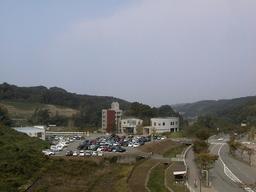
|
In Kanazawa University, all short-term (up to one year) exchange
students are placed by default in a special dormitory called Kanazawa
University International House, or kokusaikouryuukaikan
(国際交流会館) if you prefer the Japanese term. The Kakuma campus is about 6
kilometers away from the center in a rather quiet area: there are more
trees than buildings around. Grasshoppers are louder than the noise
from the road, at least during night time.
|
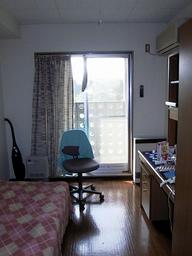
|
Each room is 14 m^2 in size which includes a tiny bathroom and a
kitchen, and behind the window you can see the balcony. There are a
few funny things: to get warm water one has to start the heater from a
wall panel in advance, and there is no shower cabinet so using the
shower makes the whole bathroom wet, but it's not too much trouble to
wipe it with a towel afterwards. As an extra bonus there's an
airconditioner which will probably come quite handy during summer. For
a mere 7600 yen (about 65 euros) plus expenses a month the room is definitely
above anything from the free market for even near the same price, and
apparently quite luxurious compared to most other dormitories too.
|
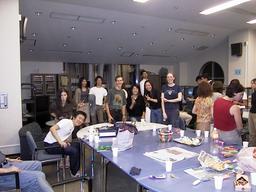
|
All residents (about 60, there are 79 rooms but some are empty if I'm
not mistaken) share a common room which has a television, sofas,
tables, reading and a few computers connected to the Internet. It is
also possible to plug your own laptop to the hub. Naturally the room
is often used for parties too. This photo is from the welcome evening
of Kanazawa International Student Station (K.I.S.S.), a group which
consist of both exchange students and Japanese who are interested to
meet foreigners.
|

|
On the first Saturday after arrival there was a flea market in front
of the International House organized by the Japanese people. Great
idea! In Japan it is usually rather hard to find second hand stuff so
this was a good opportunity to get kitchenware and some other things
for a fraction of the price of new ones. Pots and pans were hot stuff
but there were enough glasses, cups and plates for everybody. Some
lucky ones even got TV sets for 500 yen (about 4 euros) each.
|

|
While walking around the city during the first weekend I accidentally
found a festival of some local schools. It was held by the Saigawa river,
one of the two streams that cross the city. These girls were playing
traditional Japanese drums quite nicely.
|
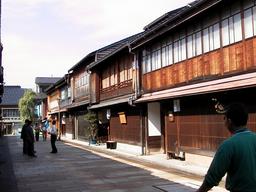
|
A large number of temples remain in various parts of Kanazawa, but
most other old houses have been either destroyed by fire or torn down
and replaced by new ones. In Higashiyama (東山) district some are
still preserved and a few of them open to tourists.
|

|
Higashiyama was built mainly in the 1820's and one of the buildings is
Ochaya Shima (お茶屋志摩). Ochaya means "a tea house", but actually it
was a place where wealthy people went to eat, drink and enjoy
entertainment performed by geishas. Tamura (田村), Miyashita (宮下)
and Ebisu (蛭子) kindly offered to be my guides for Kanazawa sightseeing
on that day.
|
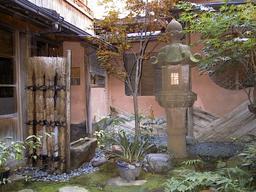
|
The garden of Ochaya Shima, featuring a typical old style Japanese
lantern.
|
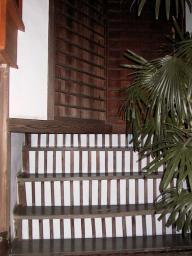
|
Myouryuuji temple, better known as Ninjadera (Ninja temple) is quite
different from what one would expect of a religious building. Quoting
one guidebook: it's a tourist trap but it's fun.
In the old days temples were not only places for worship but also
important for defence against enemies. The architectures of Ninjadera
certainly aimed to perfection towards the latter goal. The place is
full of hidden staircases, trap doors and other tricks. This is just
one example, go up these stairs and spearmen underneath can see the
shadows cast by your feet. Guided visits only.
|
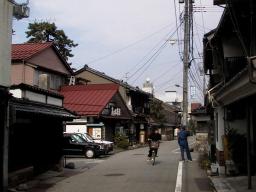
|
A typical view from a street in Kanazawa. Most of them are narrow and
bike is a convenient way to move around. This picture is from
Teramachi area, which is full of temples hidden between buildings,
yielding a total of about 70 in less than one square kilometer.
Actually to the left from the black car there's an entrance to one of
them (Ninjadera).
|
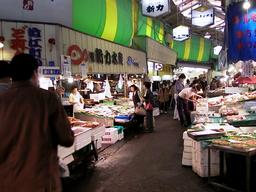
|
The Oumichou (近江町) market boasts the biggest selection of different
kinds of seafood I've seen. There are also small restaurants, I had
some excellent sashimi in one of them for a quite reasonable price.
Oumichou is also the best place to buy fruit and vegetables, they're
fresh and a lot cheaper than in supermarkets.
|
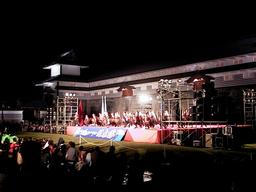
|
Sunday October 13th was a day full of different events around the
city. Traditional culture and items from Japan and other countries
were presented by the city hall at the International Friendship
Festival. Near Kenrokuen there was a big dance competition called
Yosakoi Sooran Nihonkai. Each team consisted of a few dozen people,
age varying from about 5 year old children to adults, all dancing
together and everybody seemed to have fun. Apparently the dances were
derived from old Japanese traditions but mixed with modern elements,
the music was mostly pop, rock and dance. Choreographies were well
prepared and one performance lasted about five minutes. The teams
came from various towns by the Japan west coast and if I got it
correctly there were 52 of them in total. Quite impressive!
|
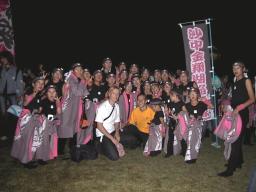
|
I approached one of the teams to take a picture and find out what the
event was all about. The people were very friendly and I and Juha (the
other Finnish exchange student here) ended up in the picture too.
Their team was called Sachuukinshoukoenbutai (沙中金翔湖焔舞隊) and
came from a town called Neagari (根上町) quite near Kanazawa. It did
quite well in the competition too, I think they came on the 6th or 7th
place.
|

|
Another group photo: these are people from the Image Information Science
laboratory where I will be writing my master's thesis. We had a
barbeque together in a park near the sea. Unfortunately professor
Muramoto is missing, he was also there but left before the picture was
taken.
And yes, while there are a lot of girls in many other faculties,
computer science seems to be mostly a playground of boys like
everywhere else. ;-)
|














